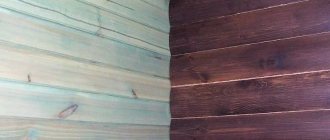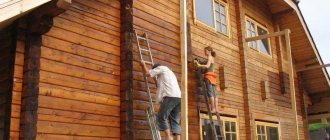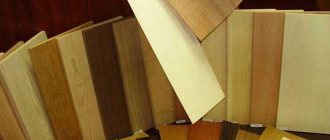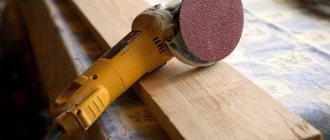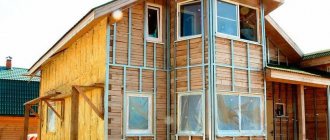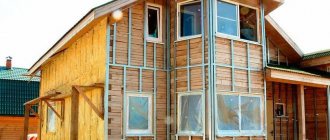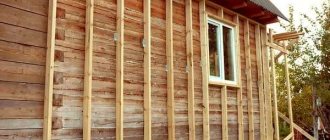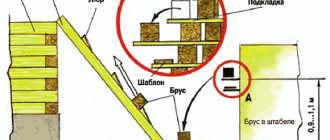Nowadays it is quite difficult to imagine houses without cladding. A wide variety of materials are used for facade finishing, including imitation timber. These products require some care and painting.
Considering that the facade made of imitation timber will have to be painted in any case, every homeowner is faced with the question of choosing the appropriate material, as well as the technology for carrying out the work.
In this article we will look at how to treat and paint wood cladding on the outside of a house.
Why paint imitation timber?
The answer to this question is on the surface, because imitation timber is one of the types of wood material for cladding the facade. Wood needs certain measures aimed at ensuring long service life, reliability and strength. Any wood material without additional measures is subject to cracking, shrinkage, drying out, rotting, and damage by insects and rodents.
To avoid any problems with wood, it is necessary to treat the cladding material using both special preparations and paints and varnishes . All compositions are capable of providing the necessary level of protection of the material from adverse factors that destroy it. It is necessary to treat the surface of a facade covered with imitation timber not only to achieve reliability and protect it from destruction, but also to maintain the attractive appearance of the entire wooden surface.
If we are talking not only about purchased material, but about the surface that has been on the building for many years, then painting may also be necessary due to loss of aesthetic appearance. A certain type of paint is used in cases where stains form on the surface of the facade, or the entire surface has darkened and lost its original appearance.
Natural flaxseed oil
This is one of the safest coatings for human health, which has long been used for treating wooden surfaces. Other advantages of the product include environmental friendliness and antiseptic protection. Linseed oil does not hide, but rather emphasizes the texture of the fake timber.
But the product also has disadvantages:
- long drying time
-
up to 3 days for one layer; - the number of layers should be at least 5–7;
- poor polymerization;
- darkening when exposed to direct sunlight.
Linseed oil is most suitable for interior decoration on structural elements that are not subject to abrasion - for example, on ceilings. This type of coating is especially suitable for valuable wood species, since it preserves its properties to the maximum.
Types of paints
It is necessary to choose a specific type of paint and varnish product based on several factors:
- degree of resistance to atmospheric conditions and mechanical influences;
- guaranteed service life;
- vapor permeability level.
Otherwise, you can focus on taste preferences regarding color (or lack thereof). It is important to pay attention to the climatic conditions in the region where the house is located.
Opaque formulations
Preference is given to this type of composition if there is no desire to preserve the natural texture of the wood . Each type of paint and varnish material has a characteristic color; it is possible to choose the one most suitable for the overall design of the building. Of the entire available range of paints containing color pigments, the following varieties are distinguished:
- oil. Despite the fact that the compositions are considered the most affordable, their quality does not always reach the desired level . They are characterized by a low level of resistance to the relative influence of UV rays. For finishing work on the facade, it is very expensive to use such paint, since it requires re-processing after two to three years, otherwise the imitation timber will begin to fade and form cracks. These paints are also distinguished by the longest period required for the composition to dry and an unpleasant odor that appears only after several days;
- alkyd. They are considered the most modern products. They have a very large selection of colors and the highest level of protective functions . The duration of preservation of color in its original form is long. As for their processing of imitation timber on the facade, they are not very reliable.
- acrylic. This variety has proven itself to be ideal for woodworking. Their range is varied and allows you to choose the option that suits you best. This type of paint is characterized by practicality and durability in comparison with other types of paint. A separate advantage is the absence of pungent odors when working with the composition. The level of adhesion of simulated timber surfaces with paint is very high. Regarding the disadvantage, there is only one – the cost of materials is slightly higher than the previous ones.
Transparent compounds
There is a term for this type of paint - glaze. These compositions are distinguished by their ability to emphasize and accentuate the natural beauty of wood, highlighting their texture. The only thing worth considering when choosing a transparent type of paint is the presence of defects, cracking or dark inclusions on the surface of the imitation timber. They will not disappear after treatment with the composition.
The following types of transparent compositions are distinguished:
- water-based compositions . They are considered the safest and most convenient to use; the main component is water;
- polymer type varnishes. Polyurethane-based materials are mainly used for external processing of imitation timber. They are characterized by the highest level of strength and wear resistance. The price of such materials is slightly higher than the previous ones;
- impregnation _ The most common of this type of transparent paint is drying oil. Despite its ease of use and good protective properties, there are the most modern compositions that have better performance characteristics;
- glaze _ Such compositions are used not only to provide protective functions to the tree, but also to give it a lighter or darker tone as needed. Wood is painted with it if there is a desire to create a “antique” effect.
Antiseptics
- Before handling, wear gloves, a protective mask and goggles.
- Clean the surface to be painted from dirt, grease and old paint with a scraper.
- Clean the board or beam with an old brush or sandpaper.
- Wash the surface with water and detergent.
- Wait until the wood is completely dry.
- Read the instructions for instructions on how to apply the product.
- Start processing wooden structures from the ends, cuts, and damaged areas.
- If it is necessary to apply several layers of coating, you should pause 2-3 hours between applying each layer.
Although we have given a list of very diverse requirements above, you can still find suitable options on the market. The industry produces the following compositions that impregnate wood:
- Oily. They extend the life of wooden surfaces, but are easily flammable, i.e. they are not suitable for a gazebo with a summer kitchen.
- Water soluble. The most popular on the market. They do not burn and are well absorbed into the material.
- Organosoluble. They enhance the strength of wood by changing its color. After impregnation, you have to paint the floor and walls with a special wood-like paint.
- Bitumen. Cheap, penetrate deeply into the material. Extend the life of boards while maintaining their presentation. Suitable for multi-colored gazebos.
- Alkyd. Designed for unpainted surfaces. Provide good protection against adverse conditions, but are highly flammable.
- Acrylic. Do not burn, prevent the appearance of mold and fungi.
In addition to the chemical formula, impregnations existing on the market are distinguished by their purpose. The right choice will help you avoid the following problems:
- rot, drying out, cracks appearing - the air exchange of wood improves;
- ignition - the tree will resist the effects of fire longer;
- change in natural color - the beautiful wood structure of the material is preserved for a long time.
You can prepare an effective means of protection and impregnate wood from rotting and moisture using folk remedies. If the decay process has not yet covered a large area, folk recipes will help eliminate further destruction:
- Liquid glass (silicate glue). Dilute the glue in water, apply the solution with a brush to the areas where the rotting is localized. As a result of processing, a dense layer of whitish glue remains on the surface of the structure. This method is the easiest.
- Vinegar and soda. Treat the affected areas with baking soda, then spray with acetic acid using a spray bottle.
- Sulfuric acid and potassium bichromate. Mix potassium dichromate in equal parts with sulfuric acid. Impregnate wood outdoors with the solution.
- Copper sulfate. Dissolve 100 g of powder in 10 liters of water and apply the solution to the dried wood.
- Resin. For external treatment, hot resin can be used. Bring the resin to a boil and apply to dried wood. The product is not suitable for colored products, because it paints the surfaces in a dark tone.
- Salt and boric acid. Material for treating wood against fire? Mix salt (1 kg) and boric acid (50 g) in boiling water (5 l). Apply to the wooden surface several times with a break of 2 hours, giving the product the opportunity to be well absorbed and dry.
| terms of Use | Naturally, all elements located inside buildings are exposed to adverse effects much less than boards used in external structures. It should also be taken into account that inside buildings there are rooms with an unfavorable microclimate (for example, a bathroom and kitchen), which also require additional treatment |
| Material condition | For example, a heat-treated deck board does not need special protection, but as for ordinary materials, without additional work they will very quickly become unusable, and it is unlikely that they will be restored; damaged structures will have to be replaced |
| Location of nodes | Everything is simple here: if the board is visible, then most often a colorless composition or options are used that create an attractive coating. If the elements are hidden or located in the ground, then there is no question of external beauty; the most important thing is to ensure reliable protection and preserve the properties of the composition after treatment for the longest possible time |
| Features of the situation | At this point, various factors are taken into account: from financial capabilities, because the price of the compositions is often quite high, and large structures require significant volumes; the method of application is also important, because even when carrying out work with your own hands, you can use a brush, roller or spray gun |
Heat-treated pine boards are excellent for use in saunas, as they are not afraid of changes in temperature and humidity
Manufacturing companies
You can purchase a high-quality composition not only based on the above parameters, but also by paying attention to the most popular and proven quality manufacturing companies.
The most common are:
- Zobel, made in Germany. The range includes water-based paints and varnishes;
- Osmo, made in Germany;
- Tikkurila, a Finnish company;
- Termica, domestic manufacturer;
- Finncolor, made in Russia.
Natural drying oil
The product is hemp or linseed oil that has undergone heat treatment with chemical additives (oil drier) that accelerate polymerization. Drying oil does not have some of the disadvantages of raw flaxseed oil. It has a shorter drying time - 24 hours
, is not absorbed so quickly, does not change color.
But products based on vegetable oils have a common disadvantage - the absence of a hard film on the surface,
which would protect against scratching and abrasion.
Humidity is important when applying the product. For wood this figure should be at least 15–18%
, for the air in the room where work is carried out - up to
80%.
If the timber is made of oily wood, then the working surface is first degreased with white spirit. The oil is applied with a brush or lint-free cloth. Excess oil is removed after half an hour using a lint-free rag.
Important!
When applying the coating, it is important to ensure that the oil is distributed evenly. Otherwise, dark spots may form on the panels.
The oil can be given shades by adding a coloring pigment. The coating is not durable. Once every 2–3 years
it needs to be restored.
Should I apply varnish after paint?
In order not to get confused in the technology of processing imitation timber, you need to understand that the main material for such work is either paint or varnish. There is no need to treat with both compositions.
A layer of paint will provide all the necessary protective functions and give the surface the desired color (without using varnish on top of such a layer). If you do not want to paint the wood in any specific color, then it is better to use varnish and preserve the natural beauty of the material.
Acrylic coatings
Acrylic paints are actively used in European countries. They are also water based and dissolve in water. These are fairly durable coatings, which include:
- plasticizers
- give elasticity to the product and do not crack; - hardeners
- accelerate the process of film formation; - matting components
- eliminate glossy shine.
The advantages of such acrylic coatings include:
- environmental safety;
- no unpleasant odor;
- vapor permeability;
- resistance to burnout;
- rich color palette;
- protection from moisture.
The coating dries in 5–30 hours.
Acrylate paints are used for both external and internal work. Painting is carried out every 3–4 years.
This type of coatings is contained in the following brand lines:
- «Drevoplast";
- "Extra";
- "Yaroslavl colors";
- Pinotex ultra;
- Tikkurila Pika-Teho;
- Dufa.
Surface preparation
To achieve a high-quality result that will last for many years, the surface of the imitation timber must be prepared; for this, use the following recommendations:
- It is better to start work when the temperature reaches + 5 degrees Celsius;
- to ensure improved adhesion of the paint composition to wood, it is sanded and sanded;
- Next, it is recommended to prime the surface and wait for it to dry completely.
NOTE!
We should not forget about cleaning the surface, since dust particles accumulated after sanding and grinding interfere with the quality of the work. It is recommended to use a vacuum cleaner to remove dust.
At the surface preparation stage, you can use an iron brush and use it to treat the entire surface. This will ensure the deepest penetration of the composition into the wood material. In other words, this surface preparation technique is called brushing. It enhances the natural texture pattern, and the method is also suitable for giving wood an antique look.
Stain (stain)
This product penetrates deeply into the wood structure, thereby emphasizing its pattern. Unlike drying oil, it does not form a film, so the pores of the natural material remain open. Therefore, the surface at the second stage is usually coated with varnishes. There are two types of stains - water-based and organic. These products are available in liquid or powder form. The disadvantage of stain is that it does not hide surface defects. At the same time, it allows you to even out the color of the wood.
Prices for different types of stains
Surface painting
To carry out this stage of work, you can use either a roller, a brush, or a spray gun . It is still recommended to choose a brush, since it ensures the most thorough painting of the entire surface.
Paint begins to be applied only after measures have been taken to treat the wood façade with antiseptic preparations. It is also recommended to use protective compounds after antiseptics that protect the tree from the negative effects of ultraviolet radiation, such as Pinotex.
Otherwise, adhere to the following recommendations:
- It is important to dilute the paint only in accordance with the instructions in the instructions;
- to prepare the composition, you must use only a clean container;
- You should first prepare all the necessary tools for work;
- After this, apply the coating, maintaining the thinnest possible layer;
- it is necessary to paint the surface as thoroughly as possible;
- after the first or also called the base layer has completely dried, begin applying the second;
- Regarding work on the facade, painting it requires 3 to 5 layers.
NOTE!
It is recommended to paint the imitation timber before covering the façade of the house with it. This will allow the coloring composition to be distributed as evenly as possible and allow the product to dry completely.
Work examples
Imitation timber decorates the facade of the house, giving it a resemblance to a hunting lodge or log house. Horizontal panels are combined with other natural and artificial finishing materials: glass, stone, metal. Thanks to its smooth surface, wooden finishes look organic in rooms decorated in modern and classic styles.
How to use imitation timber:
- combine with plaster - the facade looks elegant, the tandem of wood and plaster also looks original inside;
- cover all external walls - a classic option for using false beams;
- combine with stone finishing of the foundation - for lovers of solid buildings in eco-style;
- highlight the outer walls of the attic with false beams - the design looks harmonious with the stone facade and forged decorative elements.
In the interior of the house, prefabricated panels are used to decorate the hall, corridors, and separate walls of rooms. False beams are suitable for zoning space, decorating stairs, and, less often, ceilings.
Applying varnish
Varnish, like paint, is recommended to be applied only after the imitation timber has been treated with an antiseptic and a composition that provides ultraviolet protection. The process of applying varnish is not much different from painting a surface.
It is necessary to apply the varnish coating in two or three layers, waiting until the previous one has completely dried . It is also worth remembering that the varnish must be applied only using a brush.
IMPORTANT!
If you choose yacht varnish to process imitation timber, then there is no need to use any additional impregnations or antiseptics. This type of varnish is self-sufficient and provides all the necessary protective and decorative properties at a high level.
Waxes
Wax paints are another product that is widely used for decorating wooden panels, including false beams. They are made from natural wax or its artificial substitutes based on petroleum products - paraffin, ceresin.
Wax paints are applied to the surface without a primer. Use a brush or cloth for this. Usually two treatments are required to achieve the required coating thickness.
When using wax paints, a pronounced film does not form on the coating. The surface turns out matte, the difference from “bare” wood is sometimes almost invisible. Wax-paints are presented for both interior and exterior use. They may contain a color that radically changes the color of the finishing material.
Advantages of wax paints:
- formation of a thin protective layer;
- closing wood pores;
- silky, matte shine;
- protection from dirt and moisture;
- antistatic effect;
- possibility of restoration of worn parts.
Reference.
To emphasize the structure of the wood and make it more expressive, some manufacturers recommend using oils as a finishing coat.
Popular products in this category:
- Tikkurila Nostalgia;
- Adler Legno-Wachs;
- Watco satin wax and others.
How to make wax with your own hands - step-by-step instructions
You can prepare such a coating for wood at home. To do this you will need:
- beeswax or carnauba wax - 1 part;
- linseed oil - 1 part;
- rosin - 5% of the total mass.
Sequencing:
Step 1.
Grind the wax and rosin.
Step 2.
Place the wax in a water bath and wait until the substance melts.
Step 3.
Add vegetable oil and rosin to the container without removing from heat.
Step 4.
Mix until smooth.
The finished mixture is poured into a convenient container. If the product is not used immediately, then place it in a dark place and store no longer than 6 months.
Reference.
The more oil in the composition, the more liquid the coating. Coloring pigments can be added to the composition.
Factory painted boards
In addition to the fact that it is possible to paint imitation timber, you can independently give it the desired texture and color. There is an opportunity to purchase ready-made products; you certainly won’t have to doubt the quality.
The production dyeing technology at the factory involves processing the product from all edges. Such a process cannot be carried out independently if the façade has already been finished with imitation timber.
During production painting, grinding is carried out on a machine . This is necessary to eliminate any error that cannot be avoided by hand-dying the products. A certain composition thickness parameter is observed, equal to 40-60 microns.
By applying paint or varnish manually, this parameter is very difficult to achieve, but it is quite important . If the paint is thinner than the specified parameter, it will not last for a long time. If you apply a layer more than permissible, this threatens the loss of elasticity, which is characteristic of wood material.
The colors and textures of the products are very diverse. In the process of industrial painting, imitation timber is given any colors that imitate various tree species, for example, pine, spruce, larch, alder, oak and others. The same goes for texture. Products are available for sale in white, black, dark brown, and red colors.
